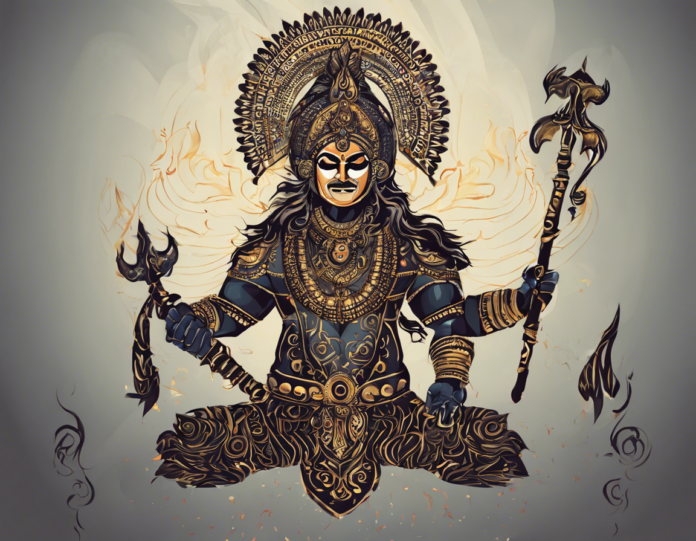The Ravan Sanhita is an ancient Hindu text that holds profound wisdom and knowledge encompassing various aspects of life. Believed to be written by the demon king Ravan himself, this scripture delves into a wide range of topics like astrology, palmistry, mantra, and tantra. It is considered to be a significant contribution to the field of mysticism and spirituality, offering insights and techniques for personal growth, self-realization, and spiritual enlightenment.
The Origins of Ravan Sanhita
Legend has it that Ravan, the antagonist in the Hindu epic Ramayana, was a learned scholar and a master of numerous subjects including astrology, Ayurveda, and meditation. The Ravan Sanhita is said to be a compilation of his teachings and experiences, passed down through generations. Though the authenticity of its authorship is often debated, the text’s teachings have been revered and practiced by spiritual seekers for centuries.
Key Teachings and Subjects Covered
The Ravan Sanhita covers a wide array of subjects, each offering valuable insights and practices for seekers on the spiritual path. Some of the key teachings found within this text include:
Astrology and Planetary Influences
One of the central themes of the Ravan Sanhita is astrology, with detailed explanations of planetary movements, their effects on individuals, and methods to mitigate negative influences. The text provides guidance on how to analyze birth charts, predict future events, and suggest remedies to overcome astrological challenges.
Palmistry and Hand Analysis
Another significant aspect of the Ravan Sanhita is palmistry, the art of analyzing the lines and marks on an individual’s palms to reveal insights into their personality, past, and future. The text provides detailed instructions on how to interpret these markings and use them for personal growth and self-awareness.
Mantras and Tantras
The Ravan Sanhita also delves into the practices of mantra and tantra, sacred sounds and rituals used to invoke divine energies and spiritual powers. The text provides a comprehensive guide on how to chant mantras, perform tantric rituals, and harness spiritual energies for protection, healing, and manifestation.
Spiritual Practices and Meditation Techniques
In addition to the above, the Ravan Sanhita offers various spiritual practices and meditation techniques aimed at deepening one’s connection with the divine, attaining higher states of consciousness, and experiencing inner peace and bliss. These practices are designed to purify the mind, body, and soul, leading to spiritual enlightenment and self-realization.
Relevance in the Modern World
Despite being an ancient text, the wisdom found in the Ravan Sanhita remains highly relevant in the modern world. In an era marked by stress, uncertainty, and spiritual seeking, the teachings of this scripture offer solace, guidance, and practical tools for individuals to navigate life’s challenges and elevate their consciousness.
Self-Discovery and Personal Growth
The Ravan Sanhita provides seekers with valuable tools for self-discovery and personal growth. By understanding their astrological influences, palmistry readings, and inner spiritual nature, individuals can gain deeper insights into themselves and unlock their true potential.
Healing and Wellness
The practices of mantra and tantra detailed in the Ravan Sanhita can be powerful tools for healing and wellness. By harnessing the vibrational energies of sacred sounds and performing tantric rituals, individuals can address physical, emotional, and spiritual imbalances, promoting holistic well-being.
Spiritual Enlightenment
Ultimately, the goal of the Ravan Sanhita is to guide seekers on the path to spiritual enlightenment. Through dedicated practice, meditation, and adherence to the teachings of this scripture, individuals can transcend their egoic selves, connect with the divine source, and experience profound states of spiritual awakening.
Frequently Asked Questions (FAQs)
1. Is the Ravan Sanhita accessible to everyone, regardless of their spiritual background?
Yes, the teachings of the Ravan Sanhita can benefit individuals from all spiritual backgrounds. The text offers practical wisdom and techniques that can be applied by anyone seeking self-realization and spiritual growth.
2. Are the astrological predictions in the Ravan Sanhita accurate?
While the Ravan Sanhita provides guidelines for astrology and planetary influences, the accuracy of predictions may vary based on the practitioner’s understanding and proficiency in the subject.
3. How can one start practicing the mantras and tantras mentioned in the Ravan Sanhita?
Seekers interested in practicing the mantras and tantras from the Ravan Sanhita are advised to approach a knowledgeable guru or spiritual teacher who can provide guidance on proper pronunciation, intention, and application of these sacred practices.
4. Can palmistry readings from the Ravan Sanhita help in making important life decisions?
Yes, palmistry readings from the Ravan Sanhita can offer valuable insights that may aid individuals in making informed decisions about their life path, career choices, relationships, and personal development.
5. Is it necessary to believe in Hinduism to benefit from the teachings of the Ravan Sanhita?
While the Ravan Sanhita has roots in Hindu spirituality, its teachings are universal and can be embraced by individuals of all faiths and backgrounds seeking spiritual wisdom and self-discovery.
In conclusion, the Ravan Sanhita stands as a timeless repository of ancient wisdom and knowledge, offering seekers a roadmap to self-realization, spiritual growth, and enlightenment. By delving into its teachings, practicing its techniques, and embodying its principles, individuals can embark on a transformative journey towards realizing their true divine nature and manifesting their highest potential.

